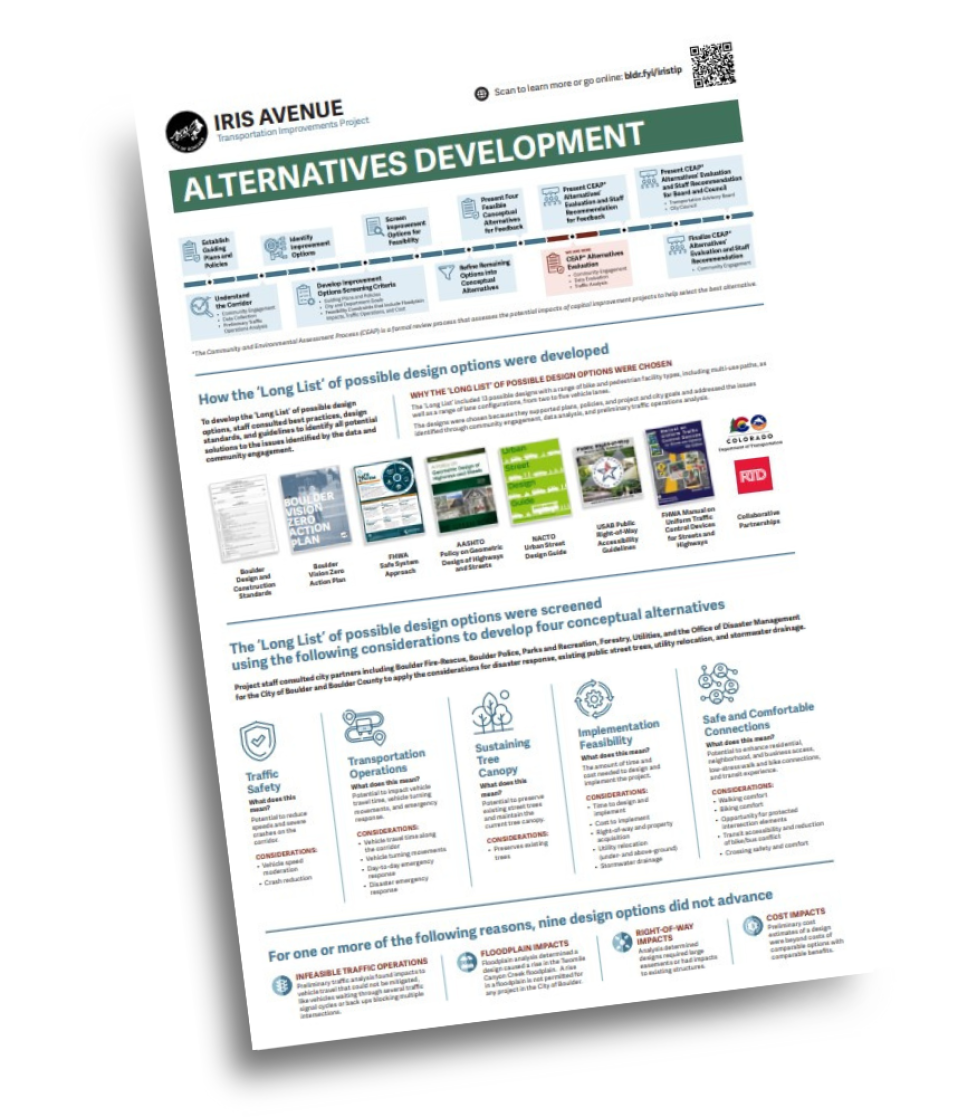
Holiday Closures
In observance of the Christmas and New Year’s holidays, the City of Boulder is adjusting its operations schedules.
View the printable Fact Sheet PDF or explore this page for the web-accessible version.


To develop the ‘Long List’ of possible design options, staff consulted best practices, design standards, and guidelines to identify all potential solutions to the issues identified by the data and community engagement.
The ‘Long List’ included 13 possible designs with a range of bike and pedestrian facility types, including multi-use paths, as well as a range of lane configurations, from two to five vehicle lanes. The designs were chosen because they supported plans, policies, and project and city goals and addressed the issues identified through community engagement, data analysis, and preliminary traffic operations analysis.

The ‘Long List’ of possible design options were screened using the following considerations to develop four conceptual alternatives.
Project staff consulted city partners including Boulder Fire-Rescue, Boulder Police, Parks and Recreation, Forestry, Utilities, and the Office of Disaster Management for the City of Boulder and Boulder County to apply the considerations for disaster response, existing public street trees, utility relocation, and stormwater drainage.
| CaTEGORIES |
Traffic |
Transportation |
Sustaining |
Implementation |
Safe and |
|---|---|---|---|---|---|
| What does this mean? | Potential to reduce speeds and severe crashes on the corridor. | Potential to impact vehicle travel time, vehicle turning movements, and emergency response. | Potential to preserve existing street trees and maintain the current tree canopy. | The amount of time and cost needed to design and implement the project. | Potential to enhance residential, neighborhood, and business access, low-stress walk and bike connections, and transit experience. |
| Considerations |
|
|
|
|
|
For one or more of the following reasons, nine design options did not advance
| INFEASIBLE TRAFFIC OPERATIONS | FLOODPLAIN IMPACTS | RIGHT-OF-WAY IMPACTS | COST IMPACTS |
|---|---|---|---|
| Preliminary traffic analysis found impacts to vehicle travel that could not be mitigated, like vehicles waiting through several traffic signal cycles or back-ups blocking multiple intersections. | Floodplain analysis determined a design caused a rise in the Twomile Canyon Creek floodplain. A rise in a floodplain is not permitted for any project in the City of Boulder. | Analysis determined designs required large easements or had impacts to existing structures. | Preliminary cost estimates of a design were beyond costs of comparable options with comparable benefits. |
This is a text alternative to the image: PDF covers of various plans and guidelines, and partner logos, including the Boulder Design and Construction Standards, Boulder Vision Zero Action Plan, FHWA Safe System Approach, AASHTO Policy on Geometric Design of Highways and Streets, NACTO Urban Street Design Guide, USAB Public Right-of-Way Accessibility Guidelines, FHWA Manual on Uniform Traffic Control Devices for Streets and Highways, and collaborative partnerships.
This is a text alternative to the timeline image. This graphic shows the Alternative Process for the Iris Avenue Transportation Improvements project. The first step was to Establish Guiding Plans and Policies. The second step was to Understand the Corridor. The third step was to Identify Improvement Options. The fourth step was to Develop Improvement Options Screening Criteria. The fifth step was to Screen Improvement Options for Feasibility. The sixth step was to Refine Remaining Options into Conceptual Alternatives. The seventh step was to Present Four Feasible Conceptual Alternatives for Feedback. The current and eighth step is CEAP Alternatives Evaluation. The ninth step will be to Present CEAP Alternatives Evaluation and Staff Recommendation for Feedback. The tenth step will be Finalize CEAP Alternatives Evaluation and Staff Recommendation. The final and eleventh step will be to Present CEAP Alternatives Evaluation and Staff Recommendation for Board and Council.